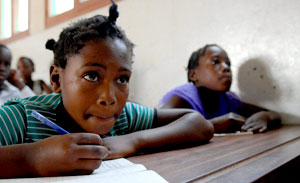Richard Florida: vrouwen winnaars kenniseconomie

Florida schrijft op zijn Creative Class blog de volgendebeschouwing daarover en komt met
‘Women make up the majority of the U.S. workforce and an evenlarger majority of knowledge, professional, and creative workers.In a provocative and controversial
But economic opportunity for women varies widely across theglobe, according to an important new measure, the Women’s EconomicOpportunity Index, released recently by the Economist IntelligenceUnit (EIU). The Index provides an empirical gauge of the status andopportunity afforded women across 113 nations. Spanning 26 separatevariables on women in the labor market, educational outcomes andopportunity, women’s legal and social status, access to finance,and the general business environment, it is drawn from data fromthe World Bank, the UN, the International Labour Organization, theWorld Economic Forum, and the OECD, along with a series of newindicators.
Women’s economic opportunity is substantially better in the moreadvanced, wealthier nations of Scandinavia and Northern Europe, theU.S. and Canada, Australia and New Zealand. Scandinavian andNorthern European nations take the top five spots. Sweden tops thelist, followed by Belgium, Norway, Finland, and Germany. Canadaranks ninth and the U.S. 15th.
The Economist study finds a clear relationship between women’seconomic opportunity and income levels. Women have become morefully integrated into the wealthier nations across virtually everydimension. But this is not the case in less-developed countries. Intoo many of these nations, writes Leo Abruzzese, one of the authorsof the study, “Women have fewer educational and employmentopportunities than men, are more often denied credit, and enduresocial restrictions that limit their chances for advancement. Insome developing countries, women still cannot vote, own property,or venture outside the home without a male family member.”
This begs the question: To what degree is growing economicopportunity for women associated with the economic development ofnations broadly? It stands to reason that economies that affordwomen more opportunity will gain economic advantage for thesimple reason that they can tap a broader reservoir of talent andskill.
With the help of my colleague Charlotta Mellander, I decided totake a look at the the connections between women’s economicopportunity and a range of key economic and social factors. We rana basic correlation analysis and generated a series ofscattergraphs of the factors that might be associated with greatereconomic opportunity for women. The graph above summarizes our keyresults. As usual, I point out that these are preliminary,exploratory analyses that simply point to associations betweenvariables. We don’t make any claims about the direction ofcausality, and we acknowledge that intervening variables may comeinto play.
Economic opportunity is closely associated with a nation’s levelof economic output and overall economic competitiveness. TheWomen’s Economic Opportunity Index is closely associated with botheconomic output, measured as Gross Domestic Product (with acorrelation of .87), and with the World Economic Forum’s basicmeasure of economic competitiveness (.76).
But other factors may matter as well, over and above the effectsof income or the level of economic development. For one, as Rosinand others argue, the rise of the knowledge economies appears tohave tilted the economic playing field toward women. To what degreethen is women’s economic opportunity associated withpost-industrial economic structures defined by higher levels ofeducation and higher levels of knowledge, professional, andcreative work? The Women’s Economic Opportunity Index is closelyassociated with both the level of human capital measured aseducation attainment (.8) and with the percentage of workers increative class fields (.81) spanning science, technology, businessand management, heath care, education, arts, culture, media, andentertainment.
The general openness of nations is also likely to play a role.Do women have more economic opportunity in nations that are moreopen, diverse, and tolerant in general? Using data from the GallupOrganization on attitudes toward gays and lesbians and towardracial and ethnic minorities, we find that the Women’s OpportunityIndex is closely associated with each (a correlation of .43 withattitudes toward racial and ethnic minorities and .74 withattitudes toward gays and lesbians).
This brings me to the broader question of human development andhappiness: To what degree is greater economic opportunity for womenassociated with greater human development overall and with higherlevels of happiness and life satisfaction? The Women’s EconomicOpportunity Index is closely associated with the UN HumanDevelopment Index (.86), and it is also associated with happinessas gauged by Gallup surveys (.68).
We also looked at the relationship between economic opportunityand my own overarching measure of creativity and prosperity – theGlobal Creativity Index (GCI). The GCI is a composite measure ofwhat I have elsewhere dubbed the three Ts of economic development -Technology, Talent, and Tolerance. The correlation between GCI andthe Women’s Economic Opportunity Index is quite substantial (.89),the highest of any factor in our analysis.
Women’s economic opportunity is closely associated with economicdevelopment. Women have considerably more opportunity in thewealthier, more developed nations, especially in Scandinavia andNorthern Europe. But other factors come into play. Economicopportunity for women is closely associated with the transition toknowledge-driven economic structures with higher levels of humancapital and more creative class occupations. Women’s economicopportunity is also greater in nations which are more open andtolerant generally toward gays and lesbians and racial and ethnicminorities. Overall, we find an especially close associationbetween the economic opportunity afforded women and our GlobalCreativity Index, a composite measure of national creativity andcompetitiveness. Nations where women have greater economicopportunity also have higher levels of overall life satisfactionand happiness.
Not only do women have greater opportunity in wealthier, moreopen, post-industrial nations, women are an integral component ofthe economic development equation. Nations that are more open towomen and afford them more opportunity gain economic advantage byharnessing a greater level of human skill and potential. Now, morethan ever, the path to economic prosperity requires further humandevelopment. Creating economic and social structures which developwomen’s full talents and afford them the full range of economic opportunity is a key element in securing lasting economicprosperity.’
Meest Gelezen
Wederom intimidatie van journalisten door universiteit, nu in Delft
‘Burgerschapsonderwijs moet ook verplicht worden in hbo en wo’
Raad van State: laat taaltoets nog niet gelden voor hbo-opleidingen
Vrouwen houden universiteit draaiende, maar krijgen daarvoor geen waardering
Extra geld voor bètafaculteiten is daar nooit terechtgekomen



